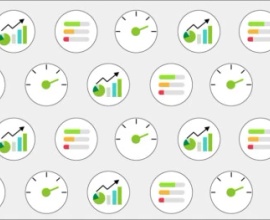Why Page Speed Matters: 10 Case Studies Show How
Page speed matters, especially with Core Web Vitals now being a ranking factor for Google. Case studies from sites like Vodafone, Yelp and Ebay show how even milliseconds can impact bounce rates, conversion rates, and ultimately your bottom line.
Having a fast-loading site is important for the customer experience, and as such, important for making money. Think about your own experience as a user — are you going to still stay on a site if a spinning wheel appears, or will you bounce back and find another that gets you to what you want more quickly? For most people , the faster site will be the winner.
And with Core Web Vitals now being a ranking factorRanking Factor
The term “Ranking Factors” describes the criteria applied by search engines when evaluating web pages in order to compile the rankings of their search results. Ranking factors can relate to a website’s content, technical implementation, user signals, backlink profile or any other features the search engine considers relevant. Understanding ranking factors is a prerequisite for effective search engine optimization.
Learn more for Google Search, speed matters more than ever.
But just how important is pagePage
See Websites
Learn more speed? And how much can it impact your bottom line?
To help answer this, we’ve compiled the latest page speed case studies that highlight the importance and benefits of having a fast site. The case studies span across several industries and business sizes, as well as feature a variety of different performance related metrics, including Core Web Vitals.
A primer on Core Web Vitals
But before we dive in, it’s important that we cover Core Web Vitals because of their roles in the case studies we cover below.
Core Web Vitals are a set of user-facing metrics related to speed, responsiveness and visual stability, to help site owners measure user experienceUser Experience
User experience (or UX for short) is a term used to describe the experience a user has with a product.
Learn more on the web.
Google’s Page Experience Update merges Core Web Vitals with existing User Experience ranking factors to form a new ranking factor category called "Search signals for page experience". This means Core Web Vitals will now be a ranking factor for Google.
The Web Vitals metrics are split into Core Web Vitals and non-Core Web Vitals.
The Core Web Vitals are:
- Largest Contentful Paint (LCP): measures the time in seconds from when the page starts loading to when the largest text block or image element is rendered on the screen.
- First Input Delay (FID): measures the time in milliseconds from when a user first interacts with your site to when the browser is able to respond to that interaction.
- Cumulative Layout Shift (CLS): measures the cumulative score of all unexpected layout shifts within the viewport that occur during a page’s entire lifecycle.
And the non-Core Web Vitals are:
- Total Blocking Time (TBT): measures the total time in milliseconds between First Contentful Paint (FCP) and Time To Interactive (TTI) where the main thread is blocked long enough to make it unresponsive to user input.
- First Contentful Paint (FCP): measures the time from when a page starts loading to when any part of that page’s content is rendered on the screen.
- Speed Index (SI): measures how quickly the contents of a page are visibly populated during page load.
- Time to Interactive (TTI): measures the time from when the page starts loading to when it's fully interactive.
As we mentioned before, Core Web Vitals are a ranking factor for Google Search as part of the new page experience signals. And next to that, it’s always important to provide users with a good experience on your site.
So now that we’ve covered Core Web Vitals, let’s check out the case studies!
1. Google: Page load speed increases bounce rate by 123%
- Year published: 2017 (updated in 2018)
- Metrics covered: Load speed, bounce rate, conversionConversion
Conversions are processes in online marketing that lead to a defined conclusion.
Learn more rate - Read here: Think with Google
Google did an analysis of 11 million mobile ads’ landing pages spanning across 213 countries, and found that a majority of mobile sites were too slow for users' expectations. For each second it took for a page to load, the probability of a mobile site user bouncing increased — and as a result the probability of conversion decreases, even dropping as dramatically as 95%.
2. Vodafone: 8% more sales by optimizing Core Web Vitals
- Year published: 2021
- Metrics covered: Visitor rate, visitor to cart rate, conversion rate
- Read here: Web.dev
Running an evenly weighed A/B test on a landing page, Vodafone found that optimizing Core Web Vitals had a positive impact on the customer journey. The test measured two visually and functionally identical pages, the only difference was the optimized page had a 31% better LCP score than the baseline page. The results showed that optimized landing page had an 8% increase in sales.
Why this is important
Having a fast LCP tells users that a page is useful, and as a result, keeps them on your site. There’s several factors that potentially could be hurting your LCP. Learn what causes a poor LCP score.
3. Yelp: Optimizing FCP boosted conversions by 15%
- Year published: 2021
- Metrics covered: Conversion rate
- Read here: Yelp
Yelp recently added new features for advertisers to have more control over their ad campaigns. But when they added these new features, they compromised speed with page load times increasing from 3 seconds to 6 seconds. The development team combatted this slowdown by optimizing FCP and TTI metrics, resulting in a site that provides both a great UX experience while also boosting conversions by 15%.
Why this is important
If your site's FCP score is > 3s, it's considered slow. High server response times and render-blocking resources are common causes for a poor FCP score. Read about what you can do to improve FCP.
4. Akamai: 100-millisecond delay hurt conversion rates by 7%
- Year published: 2019
- Metrics covered: Load speed, bounce rate, conversion rate
- Read here: Akamai
Akamai analyzed data from over 10 billion visits to top retail sites and found that even milliseconds matter. The case study shows that even the smallest amount of time can lead to customers going elsewhere, with over half of mobile shoppers leaving a page if it takes longer than just three seconds. Even delays down to the millisecond can lower conversion rates.
7% increase for 100ms win? But how, is what I often get. Think about situational disabilities when talking about accessibility, and apply this to (technical) UX.
Core Web Vitals is more than just one page speed metric. And users might then respond differently to unexpected behaviour (layout shifts / CLS, non-responding interface / FID). The same applies to your cell phone reception, your device and its CPU. If its battery runs low or it’s warmer tomorrow, the device will have a harder time rendering a webpage. One of the challenges of today's web where JavaScript increases.
Part of your audience might always end up having poor UX due to a combination of circumstances. Another part of your visitors might end up in the ‘good bucket’ today and in an orange or poor bucket tomorrow. But maybe browsing your webshop with the same expectation. Do you expect users across all UX buckets to proceed purchasing a product?
5. Ebay: Better ROI with 100ms improvement in load time
- Year published: 2020
- Metrics covered: Conversion rate
- Read here: Ebay Engineering Blog and Web.dev
Ebay set forth a company-wide initiative focused primarily on above-the-fold content. They used metrics like Time To First Byte (TTFB) and Time to Above The Fold (TATF) to guide their efforts — however optimizations were only possible if certain parts of the customer journey were cut. By making certain cuts and improving above-the-fold content, pages loaded 12% faster and resulted in a 0.5% “Add to Cart” increase.
Why this is important
Satisfying a searcher's intent quickly is important for customer experience and SERP rankingsRankings
Rankings in SEO refers to a website’s position in the search engine results page.
Learn more. In recent years, this has become a major ranking factor for search engines. Here’s best practices to help improve Time to Interactive (TTI) .
6. Propellernet: Faster visits 34% more likely to convert
- Year published: 2020
- Metrics covered: Conversion rate
- Read here: Propellernet
Propellernet wanted to know if it was really true that a faster site meant higher conversions, and if it was, was it a noticeable difference? This led them to do an experiment using real time monitoring tools to track landing page speed metrics down to the millisecond, on both desktop vs. mobile and iOS vs. Android. And the theory was correct, faster-than-average visits were 34% more likely to convert versus slower-than-average visits.
We used our site speed monitoring tool Blackbird to track whether visitors who saw faster page load times were more likely to convert. This was definitely true for total page load time, where we found faster-than-average visits were 34% more likely to convert, but it’s also true for visits that saw faster First Contentful Paint and Largest Contentful Paint timings.
Mobile visits where FCP was faster-than-average were 32% more likely to convert, while mobile visits where LCP was faster-than-average were 27% more likely to go on to convert.
Why this is important
Data is collected and reported differently for field data and lab data, which leads to variations in results. This means Web Vital metrics can look different depending on location, device, network connections. Compare the differences between field data and lab data here.
7. Pfizer: Set speed budget reduced bounce rate by 20%
- Year published: 2019
- Metrics covered: Bounce rate
- Read here: Think with Google
Pfizer found that up to 15 of their sites for over 40 brands were loading very slow — including one that took a staggering 21 seconds to load. To fix this problem, they set a speed budget that they decided was an acceptable load time, and any new images or functionality had to adhere to it. The set budget worked, resulting in sites loading 38% faster and bounce rates being reduced by 20%.
8. Portent: 0-4 Seconds is the ideal page load time
- Year published: 2019
- Metrics covered: Load speed, conversion rate
- Read here: Portent
Portent looked at data from 94 million page views across 10 ecommerce sites, covering nation-wide retailers to small niche brands in both B2B and B2C. The aim of the study was to find how much speed impacts conversion rates. The results showed that the dropoff for conversions is much steeper after 5 seconds of loading time— making the ideal page load time between 0-4 seconds.
Why this is important
Site speed matters for not only users, but also crawl budget. Faster page load time means Google can crawl more pages on your site, and new content can be discovered and indexed quicker. Read about how to maximize your crawl budget.
9. Agrofy: 76% reduction in the abandonment rate
- Year published: 2020
- Metrics covered: Abandonment rates, site exits, user engagement
- Read here: Agrofy
Agrofy found that there was a significant amount of time until users saw the main image on their site. To address this issue, they optimized the site’s Core Web Vitals — focusing on FCP, LCP, CLS — leading them to reduce the abandonment rate on product detail pages with 76%, going from 3.8% to 0.9%.
Passing all core web vitals ensures that users will have an agile and organic navigation experience, especially in a Marketplace.
A low CLS avoids frustration, resolving the LCP fastly reduces the abandonment, a good level of FID improves trust and that increases the conversion chances. Finally, these improvements are reflected with an increase of the organic traffic and with customer transactions.
Why this is important
To pass the Core Web Vitals assessment, you need to score “good” for all three Core Web Vitals based on real-user data ("field data"):
- Largest Contentful Paint (LCP)
- First Input Delay (FID)
- Cumulative Layout Shift (CLS)
See our recommended tools for monitoring Core Web Vitals.
10. TUI: More collaboration reduced load times by 78%
- Year published: 2019
- Metrics covered: Bounce Rate, Conversion rate
- Read here: Think With Google
TUI initiated an organizational overhaul to improve site performance — knowing that regardless of price points or promotions, they couldn’t increase revenue if users were still leaving the site because of slow speed. With buy-in from execs and cross-team collaboration, the engineering team had the support they needed to reach speed targets much faster. The outcome of this restructure was a 78% decrease in load time and a 31% decrease in bounce rate.
Bonus: 100ms in Extra Load Time Cost Amazon 1% Revenue
- Year published: 2006
- Metrics covered: Conversion rate
- Read here: Amazon Page Speed Study
In 2006, Amazon found that every 100ms in added page load time cost them 1% in sales. This Amazon case study is one of the most well-known and referenced in relation to page speed and performance metrics.
Despite being over 10 years old, the key takeaway still remains: having a fast site is important for your bottom line.










